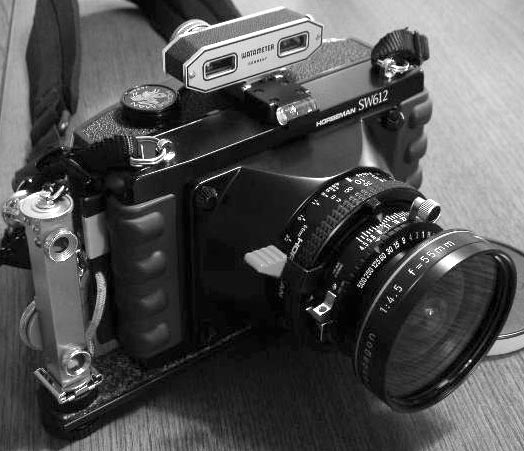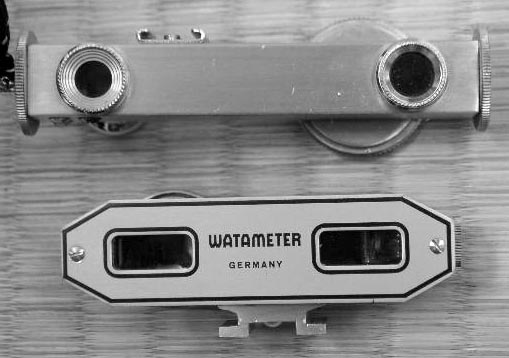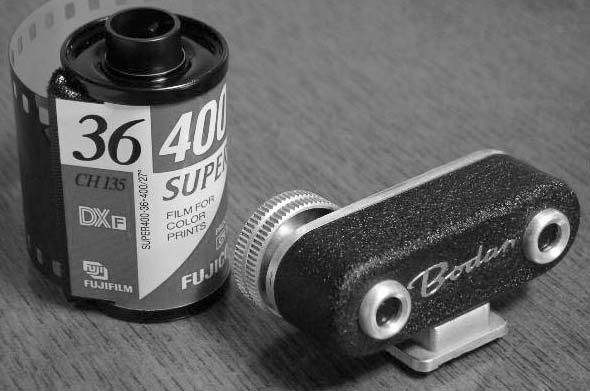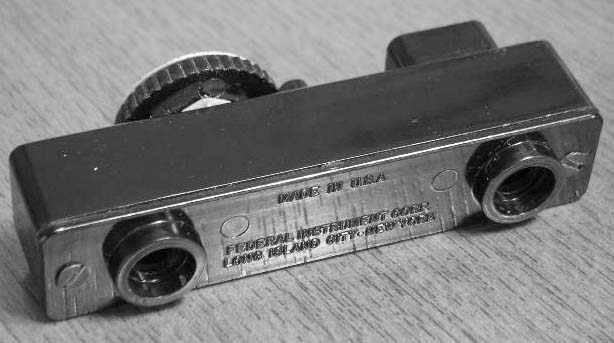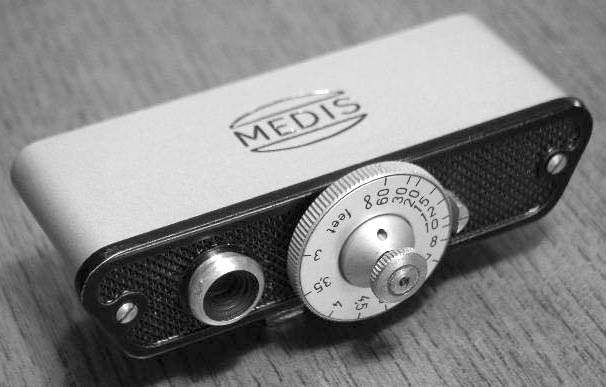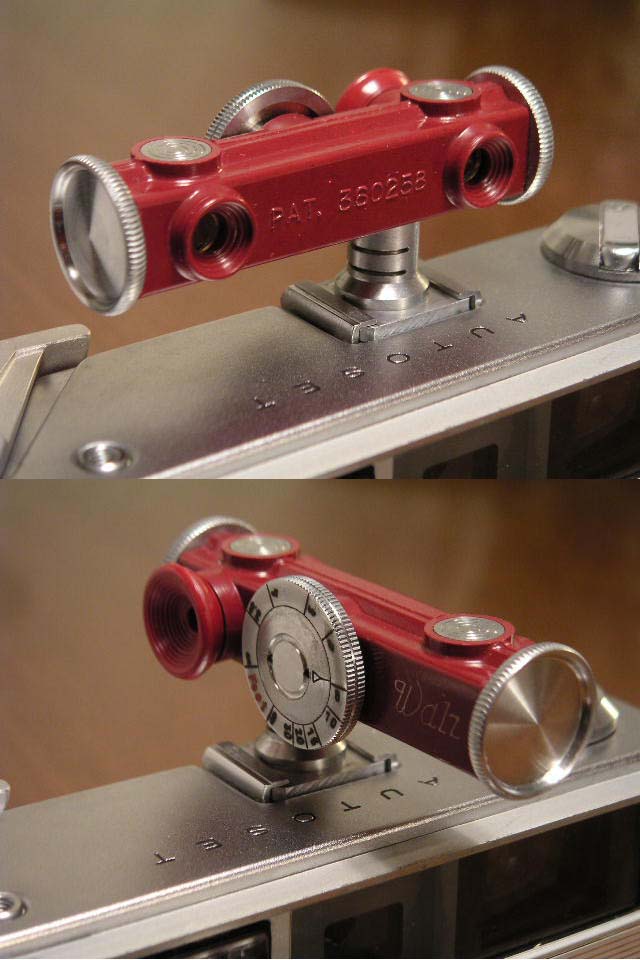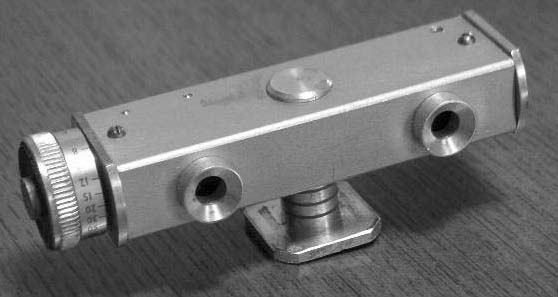Before the use of autofocus, accessory rangefinders were quite common: a rangefinder is a device to determine object distance. Most contemporary rangefinders are incorporated into the camera’s viewfinder, such as found in the Leica M series cameras, and are known as coupled rangefinders. But many cameras in the 20th century required the photographer to estimate object distances and set the focus manually. The accessory rangefinder helped increase the accuracy of that process. I had researched these devices when looking for a focusing aid for my Horseman SW612 panoramic camera. Eight rangefinders are discussed here, but there are others, most notably made by Leica.
Accessory rangefinders can be handheld or mounted directly on the camera. Two basic rangefinder designs were used: a horizontal and vertical design as shown on the top and side of my Horseman below. The rangefinder is simple to operate: simply look though it and turn the distance scale until two displaced images merge, the focus distance is then read off the scale.
Distance scales are fairly standard across devices. Most scales are in feet, but it is possible to find rangefinders calibrated in meters. The usual minimum object distance for these devices is 3ft or 1 m.
The accuracy of the rangefinder is dependent on the length of the base—the distance between the two front windows, with the greater distance giving more potential accuracy. Most rangefinders are designed for normal or wide-angle lenses with maximum apertures of f/2.8 or smaller. Rangefinders become less accurate with longer focal length lenses and wider apertures. Generally, rangefinders can be used with lenses with a maximum focal length of 135mm at object distances of 1.5 m or greater: the accuracy with shorter object distances increases as the focal length decreases.
When shopping for rangefinders, a common problem is the mirror alignment that projects the image. A horizontal alignment problem can only be detected through the inaccuracy of the rangefinder, usually after you get your film back. This can be corrected in some rangefinders by calibrating the distance scale. A vertical alignment problem will show one image above the other. For focusing on vertical features, the rangefinder will still be accurate with a vertical alignment problem. For diagonal features, range errors will occur. Some rangefinders, like the Watameter (the lower finder in the figure below), will let you adjust vertical alignment. Other rangefinders, like the Amsco DeJur (the top finder), were expected to be aligned professionally. However, if you feel confident, most rangefinders can be aligned by either taking them apart or using a few external screws on the body. I have noted which rangefinders were designed to be adjusted by the photographer, the others will require some facility by the owner to fix.
Watameter is a German unit that comes in three models. The Watameter I, shown above and below, has an external distance scale from infinity to 22 inches. The Watameter II has the same appearance and specifications, but the distance scale is read inside the finder. The Watameter Super uses an internal scale for distances between infinity and 22 inches and an external distance scale from 20 to 12 inches. All Watameter rangefinders can have the vertical alignment and distance scale calibrated by the photographer.
The Amsco DeJur rangefinder (the top rangefinder in the images above and below) is accurate and housed in a stainless steel body, which can be mounted vertically in a camera’s hotshoe. It is also an easy rangefinder to handhold because of its size. The minimum focus distance is 2.6 feet. Modeled after Leica rangefinders, the Amsco is far less expensive than its German cousins. While it is difficult to calibrate the DeJur by yourself, my unit has not needed it.
Rangefinders like the German Bodan can be very small, see image below. This model was also sold under different names. The distance scale can be in feet or meters with the minimum distance of 3ft or 1 m. The base will limit this rangefinder to normal or wide-angle lenses. The distance scale can be calibrated by the photographer, but not vertical alignment. The unit I had purchased had a vertical alignment problem, but I do not know how common that is.
The Ideal is the poorman’s rangefinder. The body is plastic and the rangefinder mechanism consists of two mirrors on a simple channel rod moved by a screw. The windows are open, allowing dust to enter the body. It has to be handheld as there is no mounting shoe. It has a long rangefinder base and is quite accurate. The distance scale is in feet with a minimum focus distance of 2.5ft and can be calibrated. My unit had no vertical alignment problems, but there is no real mechanism to align it if it does. For a carefree, inexpensive rangefinder, this is ideal.
The Medis rangefinder is a high-quality German unit. The base is similar to the Watameter. The distance scale can be calibrated with a minimum focus distance of 3ft.
The Kodak Service rangefinder is an elegant design. One distance scale is on the front and another can be read from inside the finder. Instead of merging overlapping images, this finder merges a split image like an SLR. Minimum focus distance is 2ft. The unit can be mounted vertically in a camera hotshoe. This rangefinder cannot be calibrated by the photographer. In the sample I bought, the materials used in the optical system yellowed and darkened, making the rangefinder unusable. I do not know how common that is.
Walz rangefinders are striking because of their color. It also had a design that allows it to swivel in its mount: a shoe is mounted in the camera’s hotshoe to hold the rangefinder, which could be swung to the side to access the shutter speed dial. This design also makes removing and mounting the rangefinder simple. Of course, many shoes have been lost, so make sure one comes with the rangefinder. I have also seen the two silver caps covering the alignment screws missing. The distance scale is in feet with a minimum focus distance of 3ft. This is not designed to be calibrated by the photographer.
Accurange is a cheap rangefinder with an interesting design that has the distance scale at the end of the body. The distance scale can be calibrated by the photographer. The sample I bought was in bad shape. I do not know if this is usual for these rangefinders, but the construction seems cheap.
The only two rangefinders I have now are the Watameter I and Amsco DeJur. The others I sold for one reason or another. I would also recommend Medis, Walz, and Leica. The Ideal is inexpensive and a good finder regardless of its construction. If you can get a clear Kodak Service rangefinder, then they appear to be excellent as well. Small rangefinders like the Bodan are cute and can be used with normal and wide-angle lenses quite well, but the Watameter is not much bigger and you can easily calibrate it.

